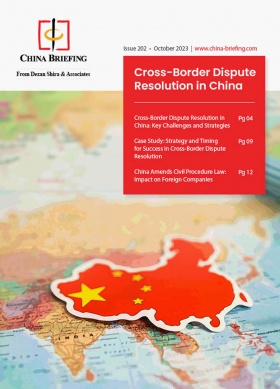Digital Recruitment in China: Definition, Strategies, and Best Practices
Over the past few years, the swift advancement of technologies, notably the Internet of Things, has highlighted the growing importance of seamless connectivity and ubiquitous data. In adapting to this changing landscape, enterprises are increasingly compelled to transition into digital entities. Meanwhile, attracting the right talent is a key driver for enterprise growth and a focal point of modern recruitment efforts, which have now become increasingly digitized. We discuss the integration of digital recruitment from various business perspectives in this article.
What is digital recruitment?
Digital recruitment is the process of leveraging digital technology and internet platforms to conduct talent acquisition activities. This approach involves utilizing various digital channels, including online recruitment websites, social media platforms, and recruitment apps, to publish job openings, screen resumes, schedule interviews, perform background checks, and make informed hiring decisions. It has made the entire recruitment process more efficient, convenient, and precise.
Digital recruitment is, however, not limited to the digitization of recruitment activities. It also includes the digitization of multiple processes—transforming the exchange of information and interaction between companies and job seekers, streamlining human resource (HR) management, and optimizing talent selection and development processes.
It is essential to recognize that digital recruitment is not merely a technical tool but a crucial component of corporate talent strategy.
What are the benefits of digital recruitment?
Digital recruitment enables companies to precisely target talent, leading to reduced recruitment costs and enhanced efficiency. Simultaneously, it offers increased opportunities and convenience for job seekers, thereby impacting how the talent pipeline is developed in the job market.
With the rapid development of big data and the internet, digital recruitment has shown its advantages over traditional recruitment. This is mainly evident in the following aspects:
- Improvement of recruitment efficiency. Traditional recruitment processes require the human resources department to spend a lot of time and effort on tasks such as posting job openings, screening resumes, and scheduling interviews. Digital recruitment, on the other hand, allows for rapid job postings through diverse channels, such as recruitment websites, social media, and recruitment platforms, attracting more job seekers. Additionally, it utilizes artificial intelligence and big data analysis to quickly identify candidates that meet job requirements, significantly shortening the recruitment cycle.
- Reduction in HR costs. Digital recruitment allows for the free or low-cost posting of job vacancies through online recruitment platforms and social media, reducing the advertising expenses associated with recruitment. Additionally, digital recruitment can decrease the human resource costs involved in the interview and hiring process, thereby enhancing the efficiency of recruitment.
- Expanded scope of recruitment. Traditional recruitment is limited by geographical and time constraints, primarily drawing in local or nearby job seekers. Digital recruitment overcomes these limitations, capturing the attention of job seekers on a national or even global scale. By leveraging the internet to post job openings, companies can cultivate a more diverse and inclusive talent pool.
- Enhances recruitment quality. Through digital recruitment platforms and websites, companies can more accurately target and screen candidates that meet specific job requirements. Additionally, digital recruitment can objectively assess candidates’ abilities and qualities through online tests and video interviews, significantly improving the accuracy and effectiveness of recruitment while reducing risks.
- Optimized recruitment experience and brand building. Traditional recruitment processes are cumbersome and complex, consuming both company resources and job seekers’ time and energy. Digital recruitment simplifies the process by enabling remote applications and interviews. Furthermore, it allows companies to build their brand image through recruitment websites and social media, attracting more outstanding talent to the company.
The digital recruitment strategies in China
Digital recruitment is not as straightforward as it looks. Companies need to adopt the right strategy in each market for optimal results:
- Companies need to have a comprehensive online recruitment platform. This platform can be the company’s own recruitment website or a third-party recruitment platform. Regardless of the approach, it is essential to ensure a good user experience—the recruitment information should be easy to find; the platform should be easy to browse; and the resume submission should be smooth and convenient. Additionally, the platform should have intelligent screening and recommendation functions to quickly find suitable candidates for the positions.
- Companies can utilize social media and professional networks to expand their recruitment channels. By posting recruitment information on platforms such as LinkedIn, WeChat, and Weibo, they can attract more job seekers’ attention and expand the reach of information through social sharing. Furthermore, companies can also use professional industry forums and blog platforms to connect with industry professionals and attract more potential talents.
- Digital recruitment can optimize the recruitment process through data analysis. Companies can collect a large amount of recruitment data using recruitment platforms and other tools, including the effectiveness of recruitment channels, candidate sources, and the time taken for the recruitment process. By analyzing this data, companies can identify bottlenecks and issues in the recruitment process and optimize recruitment efficiency and quality based on the data.
- Companies can also consider using artificial intelligence and big data technology to enhance the intelligence level of recruitment. Through artificial intelligence technology, automated resume screening and intelligent candidate recommendations can be achieved, significantly reducing recruitment manpower costs. Big data technology can help companies better understand the trends and characteristics of the talent market in order to develop better recruitment strategies and talent planning.
Some best practices in digital recruitment
Utilizing social media platforms
In light of the robust growth of social media platforms like WeChat, Weibo, LinkedIn, and others, incorporating these platforms into a company’s recruitment strategy stands as a best practice that cannot be overlooked.
In general, social media can help recruitment in the following ways:
- Social media platforms provide extensive exposure. They enable rapid dissemination of recruitment information, reaching a wider range of candidates from different industries and regions. The popularity of social media platforms is quite high. According to the “Statistical Report on the Development of China’s Internet Network” (see PDF document) released on August 28, 2023, the scale of internet users in China has reached 1.079 billion, with an internet penetration rate of 76.4 percent. The user scale for instant messaging, online videos, and short videos is 1.047 billion, 1.044 billion, and 1.026 billion, respectively, with user usage rates reaching 97.1 percent, 96.8 percent, and 95.2 percent. Therefore, mastering the window of social media platforms can better provide exposure for job positions and company information, enhancing public understanding.
- Social media platforms enable targeted recruitment. Social media platforms can push recruitment information to candidates who meet specific requirements, thereby improving recruitment efficiency. Big data can analyze candidates’ personal information, work experience, skills, and other data to help companies recruit more accurately. Specifically, by analyzing candidates’ personal information and professional background, suitable positions can be recommended based on their needs and conditions. Additionally, big data can analyze industry recruitment trends, popular positions, and salary levels, providing candidates with the latest industry developments and employment trends to better plan their career development. It also enables companies to accurately find suitable candidates.
- Social media platforms enable interactive communication. Social media platforms allow companies to interact with candidates, promptly answer their questions, and enhance candidates’ understanding of the company, thereby building trust. The timeliness and interactivity of social media are significant advantages in recruitment. Previously, communication was mostly one-way, obtained through online searches. However, social media platforms allow more efficient communication with internal company personnel, significantly reducing investigation costs. Recruiters can showcase company culture and work environment by publishing recruitment videos, employee stories, and company activities to attract more attention and understanding from job seekers.
- Social media platforms provide diverse recruitment channels. Social media platforms can attract different types of candidates through various methods such as posting recruitment information and hosting online recruitment events. The online recruitment format of social media platforms is not limited by spatial and temporal constraints, providing more flexible and convenient services for companies. Additionally, in the face of special circumstances such as the COVID-19 pandemic, online recruitment significantly reduces potential risks and ensures smooth recruitment processes.
Utilizing ATS system
Another best practice we observed is the adoption of professional software in digital recruitment. One of such professional software is the Applicant Tracking System (ATS).
ATS is a software system used to manage and track the recruitment process of applicants. Its functions include collecting and storing applicants’ resumes and application materials, screening and selecting candidates, scheduling interviews, following up on candidate progress, generating reports, and analyzing data.
To get the most out of the ATS, companies are suggested to follow the below tips:
- Implementing an ATS requires a comprehensive review and analysis of the organization’s recruitment process. Recruiters need to understand the existing problems and bottlenecks in their current recruitment process, and how to use ATS to address these issues. This may require communication and collaboration with various departments and teams to ensure the smooth implementation of ATS.
- Recruiters need to select an ATS that suits their organizational needs. This means they need to research and compare different ATS software products available in the market to find the one that best fits their organization. They need to consider factors such as system functionality, ease of use, and cost to ensure that the chosen ATS can meet their needs and improve recruitment efficiency.
Once a suitable ATS is chosen, recruiters need to implement the system and provide relevant training sessions. This includes installing and configuring the ATS, as well as training the recruitment team to ensure they can proficiently use the system. Recruiters also need to collaborate with ATS vendors to ensure the software can integrate with their existing recruitment processes and other HR management systems.
Conclusion
To summarize, digitalization is a major trend in company recruitment. It is important to seize the opportunity and get well prepared to exploit the benefits of the digital recruitment era.
On the other hand, digital recruitment involves processing of the job candidates’ personal information. Companies must develop proper personal information protection strategies during and after the recruitment process, or they will be liable to become non-compliant under China’s laws.
The information provided is for general purposes only and may not account for local variations. No liability is assumed for the completeness or accuracy of the information. For personalized advice on specific business queries, consult our experts at Dezan Shira & Associates by emailing China@dezshira.com.
About Us
China Briefing is written and produced by Dezan Shira & Associates. The practice assists foreign investors into China and has done so since 1992 through offices in Beijing, Tianjin, Dalian, Qingdao, Shanghai, Hangzhou, Ningbo, Suzhou, Guangzhou, Dongguan, Zhongshan, Shenzhen, and Hong Kong. Please contact the firm for assistance in China at china@dezshira.com.
Dezan Shira & Associates has offices in Vietnam, Indonesia, Singapore, United States, Germany, Italy, India, Dubai (UAE), and Russia, in addition to our trade research facilities along the Belt & Road Initiative. We also have partner firms assisting foreign investors in The Philippines, Malaysia, Thailand, Bangladesh.
- Previous Article China’s Cybersecurity Regulator Issues Draft Measures on Incident Reporting
- Next Article China Monthly Tax Brief: November 2023








